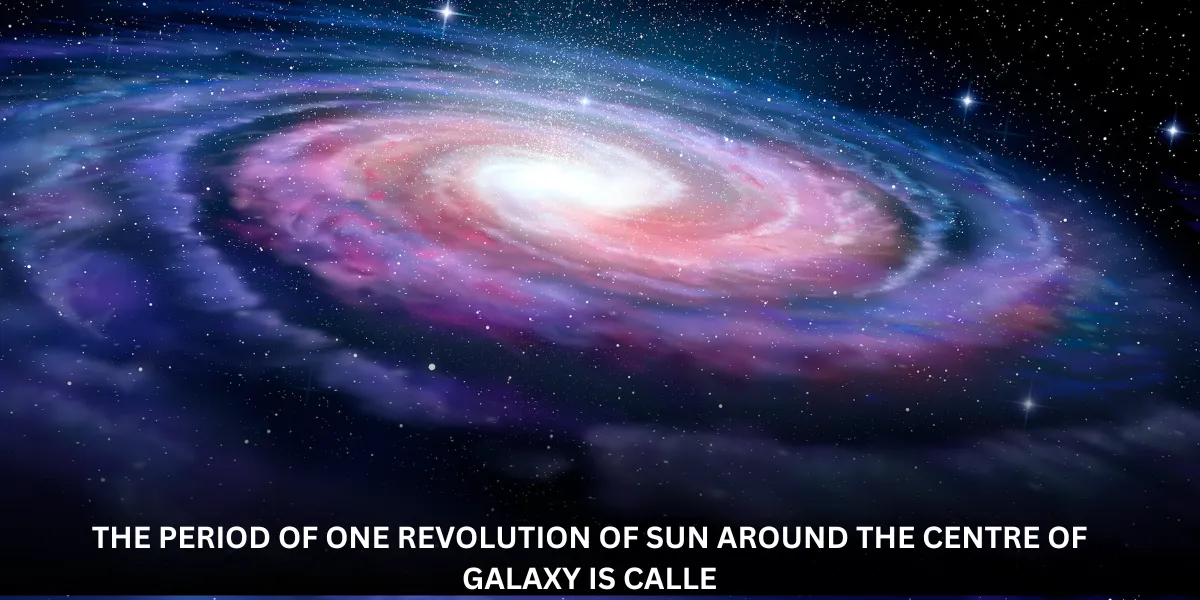the period of one revolution of sun around the centre of galaxy is calle – The Period of One Revolution of the Sun Around the Center of the Galaxy is Called a Galactic Year Most of the time, we think about time in terms of days, months, or years. However, what if we took an astronomical view of the world? Consider a clock that runs on millions of years rather than seconds. This gets us to the intriguing idea of a cosmic year, or galactic year. The period of one revolution of the Sun around the center of the galaxy is called a galactic year, an astoundingly long period of time that is thought to be approximately 225 million Earth years. The importance of this enormous era and its consequences for our comprehension of the cosmos are examined in this article.
What is a Galactic Year?
the period of one revolution of sun around the centre of galaxy is calle The time it takes for our Solar System to complete one full orbit around the Milky Way galaxy’s core is known as a galactic year. A galactic year is far longer than an Earth year, spanning over 225 million Earth years, which is based on the Earth’s orbit around the Sun and lasts for roughly 365.25 days. We can appreciate the vast scope of our galaxy and the universe at large because of this massive time.

The Journey of the Sun
Gaining an understanding of the path our Sun makes across the Milky Way is crucial to comprehending a galactic year. the period of one revolution of sun around the centre of galaxy is calle The average speed of the Sun and the Solar System’s orbit around the galactic center is approximately 828,000 km/h (514,000 mi/h). Even with this rapid speed, it takes an astonishingly long time to complete one orbit because of the great distance—roughly 27,000 light-years—that separates us from the galactic center.
How Do We Measure a Galactic Year?
Knowing how far and how fast our Solar System travels is essential to measuring such a vast amount of time. To determine the Sun’s orbital speed and distance, astronomers employ sophisticated methods and tools. A galactic year’s duration is estimated by multiplying the distance by the time it takes to travel one full orbit. Although this measurement is not exact, it provides a reasonably accurate estimate.
The Milky Way: Our Galactic Home
Stellar objects, including planets and stars, number in the billions, and the Milky Way galaxy is a barred spiral galaxy. The Orion Arm, often called the Orion Spur, is one of the spiral arms of the galaxy in which our Solar System is located. The duration of a galactic year is largely determined by the dynamics and structure of the Milky Way. Comprehending our place in this enormous galaxy allows us to better grasp the scope of the journey the Sun makes.
Historical Perspective: The Age of the Earth
In order to contextualize a galactic year, it is useful to remember that the Earth is approximately 4.5 billion years old. This indicates that the genesis of our planet only occurred only 20 galactic years ago. Most major geological and biological events throughout Earth’s history span only a few fractions of a galactic year, when we think about them. the period of one revolution of sun around the centre of galaxy is calle This setting emphasizes how short human history is in relation to the cosmos.
Life in a Galactic Year
What is the course of a galactic year on Earth? These enormous epochs bring about significant changes in biology, climate, and geology. For instance, during the Mesozoic Era, which lasted around one cosmic year, dinosaurs roamed the Earth. Over these enormous timescales, major extinction events, continental drift, and the evolution of living forms all take place, demonstrating how active our planet is overall.
Galactic Events: What Happens in a Galactic Year?
During a galactic year, changes occur in the galaxy itself, which is located beyond Earth. Black holes devour stuff, stars are born and die, and interstellar collisions can happen. The Milky Way’s evolution and structure are shaped by these occurrences. Comprehending galactic years aids astronomers in examining these mechanisms and forecasting forthcoming alterations within our galaxy.
The Influence of Galactic Years on Earth/ the period of one revolution of sun around the centre of galaxy is calle
Although the Sun’s orbit around the galactic center may appear far away and unimportant to day-to-day existence, it actually has a small impact on our planet. According to certain ideas, the location of the Solar System inside the galaxy may have an impact on the intensity of cosmic rays, which could have an impact on the temperature and the evolution of life.the period of one revolution of sun around the centre of galaxy is calle The interconnectivity of cosmic and terrestrial processes is highlighted by these linkages, which are continuously being investigated.
Comparing Galactic Years to Human Lifespans
The length of a human year is little in comparison to a galactic year. A galaxy year could be compared to a single day, making human history seem like a blink of an eye. This viewpoint serves as a helpful reminder of our fleeting life and the significance of comprehending our role in the cosmos. Because of the potential long-term effects of our activities on future generations, it also emphasizes the importance of sustainability and long-term thinking.
Scientific Significance of Galactic Years
Investigating galactic years offers important new perspectives on the dynamics of galaxies and the universe’s evolution. It aids in the understanding of the processes forming our galaxy, stellar life cycles, and the possibility of extraterrestrial life. Advances in cosmology, astrophysics, and possibly even the hunt for extraterrestrial life may result from this research.
Conclusion
the period of one revolution of sun around the centre of galaxy is calle A galactic year is the duration of one revolution of the Sun around the galactic center; this idea challenges our conceptions of space and time. Understanding the vast scope of a galactic year helps us better understand the intricacy of the universe and how we fit into it. This cosmic viewpoint broadens our understanding and piques our curiosity about the enormous universe we live in.
FAQ
1. What is a galactic year’s duration?
Approximately 225 million Earth years make up a galactic year. This is how long it takes the Solar System to travel one circle around the Milky Way galaxy’s core.
2. What factors affect how long a galactic year is?
The Solar System’s orbital velocity and distance from the galactic center determine how long a galactic year is. Changes in these variables may cause a small adjustment to the duration estimate.
3. How is a galactic year calculated by scientists?
By measuring the Sun’s orbital speed and radius around the galactic center, scientists may determine the length of a galactic year. These measurements are made with sophisticated astronomical equipment and procedures.
4. Has there been more than one galactic year on Earth?
Yes, since Earth’s birth 4.5 billion years ago, it has undergone roughly 20 galactic years. Biochemical and geological changes of great magnitude occur during each galactic year.
5. Why is it important to comprehend galactic years?
Gaining knowledge about galactic years can help us better understand the dynamics of galaxies, stellar life cycles, and the universe’s evolution. It also provides a more comprehensive understanding of time and the universe.

